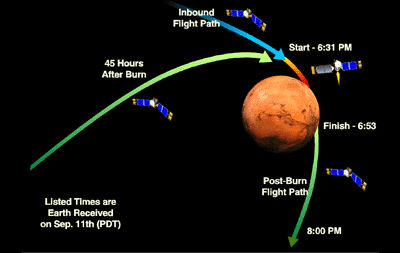 |
After completing a 10-month voyage from Earth, Mars Global Surveyor will arrive at the red planet on 11 September 1997 at 6:31 p.m. PDT. At that time, the main rocket engine will fire for 22 minutes to slow Surveyor and allow the Martian gravity to capture the spacecraft into an orbit around the planet. Without the velocity reduction from the crucial Mars orbit insertion (MOI) burn, Surveyor would fly past right past Mars.
As shown in the diagram on this page, the burn will start high over the Martian northern hemisphere with the spacecraft flying southward. The blue line indicates Surveyor's flight path prior to the start of the burn, the red line represents the burn, and the green line shows the resulting orbit after the burn is complete.
During the maneuver, gigantic antennas at the Goldstone station in California and the Canberra station in Australia will track the spacecraft's radio signal. Unfortunately, Surveyor will pass behind Mars about 12 minutes after the start of the MOI burn. At that time, the tracking antennas on Earth will lose contact with the spacecraft because Surveyor cannot transmit through the planet.
When the spacecraft reemerges from behind the planet at 6:57 p.m. PDT, the burn will already be complete. At that time, the spacecraft will be in a highly elliptical orbit around Mars that will take 45 hours to complete. The low-point of the orbit, at 250 km above the Martian surface, will be located near the position that Surveyor will pass through approximately half way through the MOI burn. The high-point of this new orbit will lie on the opposite side of the planet at an altitude of about 56,000 km.
Timeline of Events
All times are on September 11th, PDT
5:31:00 p.m.
Velocity 3,640 m/s, Altitude 13,900 km
One hour before the start of the Mars orbit insertion burn, Surveyor will still be over 10,000 km from Mars. Over the next hour, the gravity of Mars will continue to accelerate the spacecraft inward. The velocity will increase by nearly 40% and the altitude will drop by 12 km by the time the burn starts.
5:55:28 p.m.
Surveyor's flight computer will switch radio transmission to the ground from the narrow-beam, high-gain antenna to the wide-beam, low-gain antenna. At this time, the transmission of physical data from the spacecraft will also cease until after the burn is complete. However, ground based tracking stations will still be able to listen to the radio signal's tone. This situation is analogous to listening to a steady tone or beacon from a radio station, but no music.
6:14:09 p.m.
Spacecraft will begin to rotate from its Earth-pointed orientation to the orientation used for the orbit insertion burn. This rotation will take about 14 minutes.
6:31:00 p.m.
Latch valves #4 and #5 open, allowing propellant to flow from the nitrogen tetroxide oxidizer tank and hydrazine fuel tank down to the top of Surveyor's rocket engine.
6:31:09 p.m.
Velocity 5,088 m/s, Altitude 1,490 km
IGNITION - thruster rockets
These small rockets will fire before the main rocket engine to
allow the propellant to settle in the tanks and lines. This
action will ensure a smooth flow of propellant to the main engine
during the burn.
6:31:28 p.m.
The onboard computer will command Surveyor's main rocket engine first to arm, and then fire.
6:31:29 p.m.
IGNITION - main engine
This point in time marks the official start of the 22-minute Mars
orbit insertion burn. During the maneuver, the engine will burn a
combination of hydrazine fuel and nitrogen tetroxide oxidizer to
produce a thrust level of about 600 Newtons.
6:33:04 p.m.
Surveyor, moving in the southward direction, will cross over the Martian north pole at an altitude of 1,185 km.
6:43:19 p.m.
About 12 minutes into the burn, Surveyor will pass behind Mars and radio contact will be lost. Altitude at this time will be about 280 km.
6:44:26 p.m.
Surveyor will reach its point of closest approach to Mars at an altitude of 276 km.
6:50:46 p.m.
Surveyor will cross the Martian equator moving southward. The local Mars time at this crossing will be 5:47 p.m. The spacecraft will now be at an altitude of about 500 km.
6:53:48 p.m.
Velocity 4,390 m/s, Altitude 750 km
CUT OFF - main engine.
This is the predicted time that the Mars orbit insertion burn
will end. In reality Surveyor's computer is not programmed to
shut off the engine at a predetermined time, but when onboard
accelerometers detect that enough velocity reduction has been
achieved. At this time, contact with the spacecraft will not have
been reestablished because Surveyor will still be behind Mars.
The differential between the velocity at this time and the velocity at the start of the burn will not be 976 m/s. The reason is that during the first half of the burn, Surveyor will still be falling toward Mars and gaining velocity even though the main rocket engine will be firing. However, the spacecraft's velocity at any given time during the burn will be lower than if no burn occurs.
6:55:07 p.m.
The spacecraft will begin to rotate from its maneuver orientation back to a position that points its antenna directly at the Earth. This rotation will take anywhere between seven to 14 minutes.
6:57:11 p.m.
At this time, Surveyor will reemerge from behind Mars. This is the earliest time that tracking stations on the Earth will reacquire the tone from the spacecraft's radio signal.
7:07:21 p.m.
Surveyor will cross the Martian south pole at an altitude of 2,300 km.
7:09:52 p.m.
Now, with the rotation back to Earth-point complete, the onboard flight computer will enable the transmission of physical data back to Earth. This data transmission will occur at a rate of 2,000 bits per second and will contain real time information about the current status of the spacecraft.